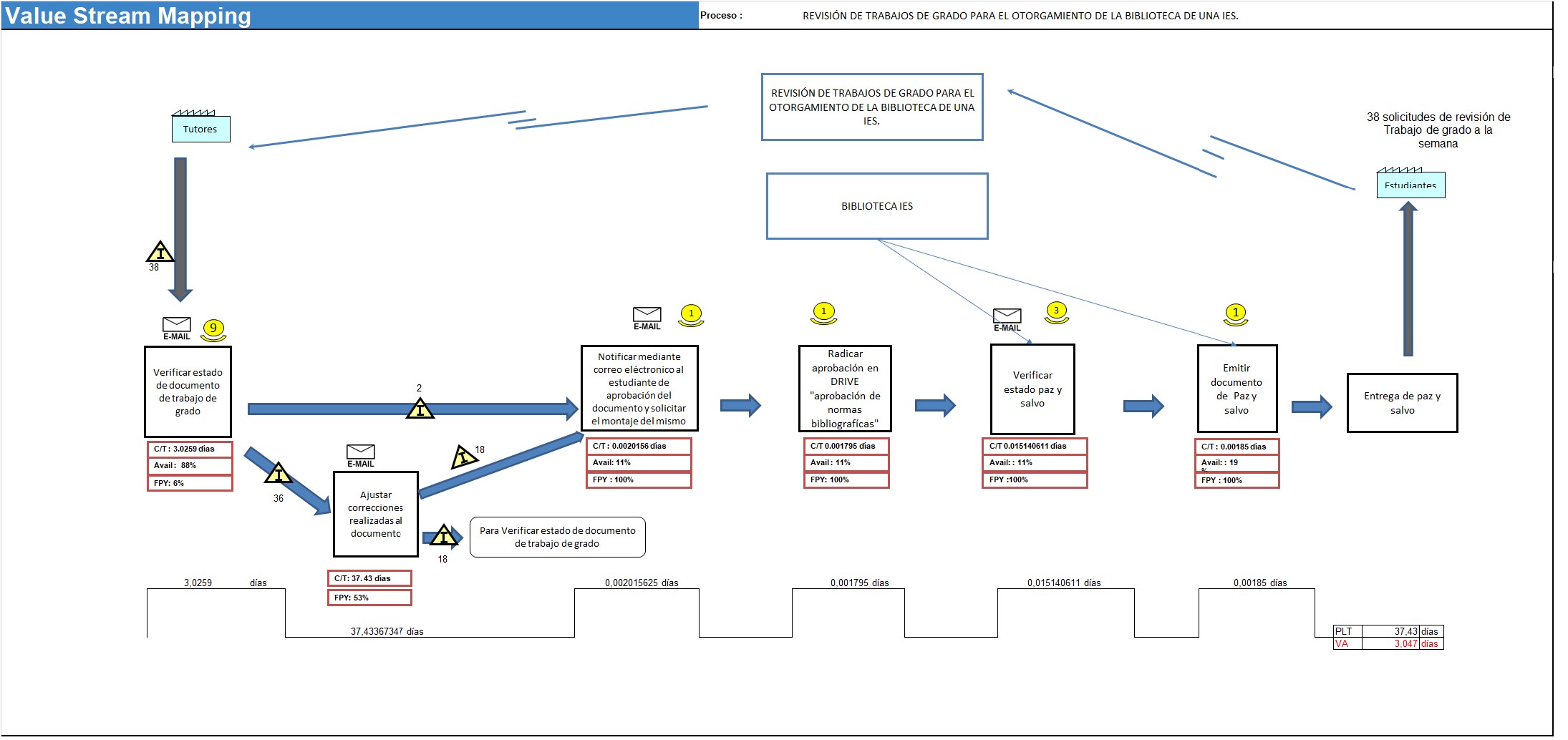Applying Lean Six Sigma for the improvement of the degree work process in a Higher Education Institution
DOI:
https://doi.org/10.22517/23447214.24773Keywords:
Lean six sigma, Higher Education Institutions, DMAIC, continuous improvement strategiesAbstract
Despite the advances in the implementation of improvement projects in Higher Education Institutions (HEIs), these have been carried out without following a general specific model that defines a clear procedure for their subsequent implementation in this type of organizations, which differs from industries where the Lean Six Sigma (LSS) methodology was created. The HEI have the degree work process to issue the certificate of the library, but this process is taking longer than expected. For this reason, the present research aims to design the improvement project through the LSS model for the aforementioned process. Applying this methodology, it was possible to diagnose the current state of the process, as well as to identify the needs of the interested parties. Finally, an action plan was proposed that would allow continuous improvement of the process aligned to provide quality, effectiveness and service to the process. From the application of these strategies, it is expected to reduce the delivery time of the process by up to 54%, increasing the Value Added indicator from 8% to 17% and increasing the First Pass Yield index by up to 40%.
Downloads
References
[1] P. Reyes. “Manufactura Delgada (Lean) y Six Sigma en empresas mexicanas: experiencias y reflexiones”. Contaduría y administración, Vol. 205, pp. 51-69. junio 2002.
[2] L. Padilla. “Lean Manufacturing”. Revista Ingeniería Primero. Vol. 15, pp. 64-69. enero 2010.
[3] C. Archila, & M, Arias, “Lean servicies aplicado en los procesos administrativos de la coordinación de proyecto social universitario y práctica profesional de la carrera de ingeniería industrial de la pontificia Universidad Javeriana”. (tesis de grado). Pontificia Universidad Javeriana. Bogotá D.C. 2013.
[4] J. Hess & B. Benjamín. “Applying Lean Six Sigma within the University: Opportunities for Process Improvement and Cultural Change”. International Journal of Lean Six Sigma, Vol. 6, no. 3, pp. 249-262. Agosto 2015.DOI: https://doi.org/10.1108/IJLSS-12-2014-0036
[5] D. Guerrero, J. A. Silva, & C.C. Bocanegra. “Revisión de la implementación de Lean Six Sigma en Instituciones de Educación Superior”. Ingeniare, vol. 27, no. 4, pp. 652-667. Diciembre 2019. DOI: https://doi.org/10.4067/S0718-33052019000400652
[6] P. S. Pande, R.P. Neuman, & R. R. Cavanangh. “Las claves prácticas de Six Sigma”. Madrid - España. Mc Graw Hill, (2004)
[7] C.F. Gómez. “Métodos cualitativos para estudiar a los usuarios de la información”. México, Universidad Nacional Autónoma de México, 2008.
[8] M. Vergel & J. Martínez. “Filosofía gerencial Six Sigma en la gestión universitaria”. Revista FACE, 15(2), 99-106, 2015. DOI: https://doi.org/10.24054/01204211.v2.n2.2015.1619
[9] D. Guerrero, & C.C. Bocanegra, “Modelo lean Six Sigma para el mejoramiento continuo en el sector educativo” en IV Congreso Internacional Industria y Organizaciones, CIIO 2017. Universidad De Antioquia. Medellín. 2017.
[10] J. Hernández, & A. Vizán. “Lean Manufacturing”. Madrid: Fundación EOI, 2013.
[11] C.C. Gómez. “Aplicación de un modelo Lean Six Sigma Orientado a la mejora de la productividad en una empresa del sector de cuero de Cali”. (tesis de grado) Cali: Universidad Autónoma de Occidente. 2019.
[12] M. Díaz. Estadística inferencial aplicada. 1.ª ed. Barranquilla, Colombia: Editorial Universidad del Norte, 2019
[13] P. S. Pande, R.P. Neuman, & R. R. Cavanangh. “Las claves prácticas de Six Sigma”. Madrid - España. Mc Graw Hill, (2004)
[14] M. Arango, & B. Ángel. “Plan de Implementación Six Sigma en el proceso de una institución de educación superior”. Prospect, vol.10, no. 2, pp. 13-21, diciembre 2012. DOI: https://doi.org/10.15665/rp.v10i2.228
[15] D.M. Cuartas, & E. Zemanate. “Aplicación de la metodología Six Sigma con la estrategia DMAIC para el mejoramiento de procesos en la unidad de cuidados intensivos de recién nacidos de centro médico Imbanaco”. (tesis de grado). Fundación Universitaria Católica Lumen. Cali, Valle. 2016.

Downloads
-
Vistas(Views): 2136
- PDF (Español (España)) Descargas(Downloads): 939
- HTML (Español (España)) Descargas(Downloads): 24
Published
How to Cite
Issue
Section
License
Copyright (c) 2023 Scientia et Technica

This work is licensed under a Creative Commons Attribution-NonCommercial-ShareAlike 4.0 International License.
Copyrights
The journal is free open access. The papers are published under the Creative Commons Attribution / Attribution-NonCommercial-NoDerivatives 4.0 International - CC BY-NC-ND 4.0 license. For this reason, the author or authors of a manuscript accepted for publication will yield all the economic rights to the Universidad Tecnológica of Pereira free of charge, taking into account the following:
In the event that the submitted manuscript is accepted for publication, the authors must grant permission to the journal, in unlimited time, to reproduce, to edit, distribute, exhibit and publish anywhere, either by means printed, electronic, databases, repositories, optical discs, Internet or any other required medium. In all cases, the journal preserves the obligation to respect, the moral rights of the authors, contained in article 30 of Law 23 of 1982 of the Government Colombian.
The transferors using ASSIGNMENT OF PATRIMONIAL RIGHTS letter declare that all the material that is part of the article is entirely free of copyright. Therefore, the authors are responsible for any litigation or related claim to intellectual property rights. They exonerate of all responsibility to the Universidad Tecnológica of Pereira (publishing entity) and the Scientia et Technica journal. Likewise, the authors accept that the work presented will be distributed in free open access, safeguarding copyright under the Creative Commons Attribution / Recognition-NonCommercial-NoDerivatives 4.0 International - https://creativecommons.org/licenses/by-nc-nd/4.0/deed.es license.


